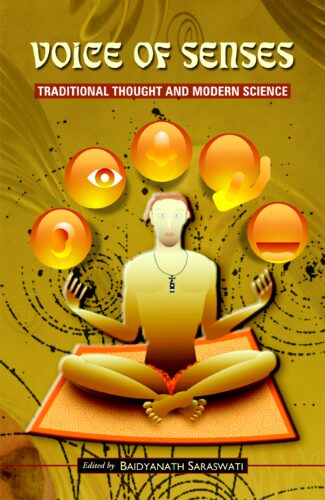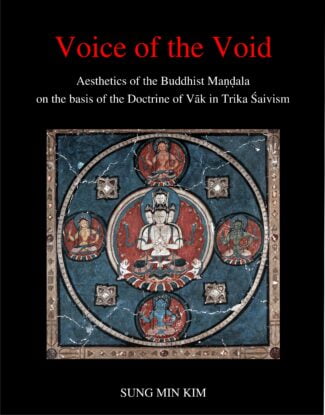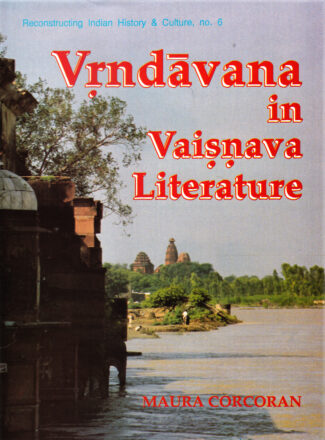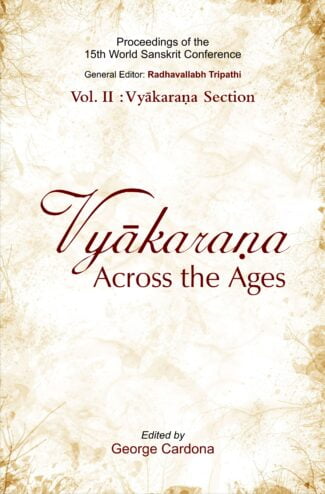Showing 1111–1120 of 1176 results

This book, presents an in-depth study of the concept of death from the distinct viewpoints of all religions and cultures and at the same time taking into account their common concept of continuity of life after death, in contrary to the biological science that adheres to the mechanism of cell-death.
If life is a reality, the death is an eternal truth. Does immortality mean clinging to body? If so, it cannot be the life artificially alive as in modern hospitals. Is extinction of species important? The recent developments in the field of molecular biology to clone the extinct animals may raise another dimension: do the species ever die? Death is not the extinction of life, it rather opens a horizon for new journey on this planet or the other. If a person elevates himself and immensely contributes to the society, he gets perpetuated and becomes immortal. Every culture has its own eschatology bearing with death, rituals, customs, beliefs and values. While the Hindus and the Buddhists adhere to the theory of reincarnation, the Muslims and the Christians hold the concept of eternal after life. In the present book, originally the proceedings of the seminar organized by the N.K. Bose Memorial Foundation, Varanasi, various distinguished scholars have richly contributed in presenting an in-depth study of the concept of death from the distinct viewpoint of all religions and cultures and at the same time taking into account their common concept of continuity of life after death in contrary to the biological science that adheres to the mechanism of cell-death. Through the social, philosophical, medical, and ayurvedic approaches to death, the existence of soul based on the ideas of immortality and ancestor-worship has been further validated. The book has demonstrated as to how this hard-headed research can illuminate a certain theory that would serve as a bridge between the physical science and social science, the purpose being to reveal the most overall general character of Nature and the nature of Man. This book would definitely appeal to all general readers and more particularly to those of philosophical temperament keen to know more about Death and also the world beyond it.

This book presents an understanding of God in various religions and traditions around the world Brahman in the Upanishads, Allah in Islam, God in Tibetan, Zoroastrian, Buddhist and Jaina faiths, the conception of the divine in Christianity and the folk deities of the Adivasi groups.
The result of a seminars proceedings, the volume presents an understanding of God in various religions and traditions around the world. It examines the concept of the Brahman in Hindu religious thought, and God as forming the relationship between the unmanifest Brahman and the manifest Universe. It views the approach of the Semitic religions that make absolute difference between God and Man. It discusses the glory associated with God, the nature of the Supreme God and His lesser denominations as well as the modern notion of God as a human creation and residing in the mind of Man. It delves into the core of the Upanishadic thought, God in Tibetan thought, signs of Allah and his attributes in Islam, God in the Zoroastrian faith, Buddhism and Jainism vis-a-vis the notion of divinity and the Christian conception of the divine. It deals with God in the Shamanic cosmogonies of some Adivasi groups of eastern India and the syncretic folk deities of Sundarbans in West Bengal. The scholars interpret the cosmological, teleological and ontological proofs, in various forms, to understand the reality of God.
The volume, with its painstaking studies, will prove invaluable to scholars and readers, mainly those associated with religious studies.

The book presents views on life from the traditional as well as modern perspectives to come up with many interpretations surveys evolution of life and extinction theories, focusing on development of life over 600 million years from simple to complex. The contributors delve into the Upanisadic and Vedic concepts of life, and the Hindu astrological and ayurvedic perception and Christian perspective of life as well.
The volume presents views on life from the traditional as well as modern perspectives to come up with many interpretations. Indologists, anthropologists, sociologists, philosophers and physical and social scientists profess that traditional thought and modern science offer two different world-views on life: the first encompassing a wholeness of life, and the other explaining the universe and life with ideas of the realm of matter alone. Referring to various ancient texts as well as thoughts of social scientists based on empirical studies, the contributors delve into the Upanishadic and Vedic concepts of life, and the Hindu astrological and ayurvedic perception of life. They examine the Christian perspective of life as well. Discussing the theme from the viewpoint of physical law, the book surveys evolution of life and extinction theories, focusing on development of life over 600 million years from simple to complex. It ponders over questions like radical difference between living and non-living matter though both consist of molecules. Connecting science to societal development, it deals with ancient community theories on life and nature taking specific ethnic communities like the Mesoamericans and the Santals in India as examples. The book is an all-inclusive and extensive study of traditional and scientific perspectives on the life origin, urges and responses, meaning and essence of life, and its development.

This volume is devoted to a thorough understanding of the concept of senses as interpreted in the ancient Asian traditions with particular reference to Indian religious and philosophical thought. It examines the functions, perception, scientific approach and the recurring cycle of Five Senses in Chinese, Tibetan and Indian philosophy.
This volume is devoted to a thorough understanding of the concept of senses as it has been interpreted in the ancient Asian traditions with particular reference to Indian religious and philosophical thought. It examines the functions of the sense-organs and the perception of them adopting a sociological and scientific approach. The first part of the presentation comments on the recurring cycle of Five Senses in Chinese, Tibetan and Indian philosophy. It takes up ancient knowledge on the senses as can be gained from the Vedas and the Upanishads, the Buddhist Abhidharma text and Jainism, as also from Islamic and Christian philosophies. They relate functioning of the sense-organs to aesthetic perception. Articles in the second part examine ethnic-cultural communities’ responses to senses and attribution of functions to them, as, for instance, the importance attached to the senses by the traditional snake-charmers. They study responses by plant and animal life to their environment and inquire into the biological processes involved in sense perceptions. Modern technology is discussed as imitating the Five Senses. These articles should be of benefit to scholars interested in learning about the different aspects of Indian religious and philosophical perceptions.

This volume examines how the perceptible form of Buddhist mandalas represents shunya (void), with special reference to the mandalas of Tabo and Alchi. On the basis of the concept of vak (subtle sound) in Trika Shaivism of Kashmir, it investigates where their aesthetic power derives from.
The research undertaken here about Buddhist mandalas is basically designed under the philosophical question how the visible dimensions of forms are related to their invisible contents. The textual sources in reference to Buddhist mandalas teach that the essence of mandalas is shunya (void) and their forms are the reflective images (pratibimba) of shunya. This volume investigates how the colourful form of Buddhist mandalas represents the prime concept of shunya, and what makes these mandalas visually powerful, leaving the impression of ßspiritual enhancementû in the heart of people who do not even know about the Buddhist doctrines.
The mandalas permanently represented in the monastic complexes of Tabo and Alchi in the Western Himalayas have been focused in order to examine a prominent role of visual dimensions of mandalas. In order to comprehend mandalas in the context of Buddhist philosophy, the texts of the Yoga-Tantra class have been looked up. Especially, the references to the tantric visualization-practice throw light on the internal experiences with mandalas.
Considering the fact that the Buddhist mandalas have been developed as a method of Mantrayana, being always combined with mantras and mudras, this volume presents the concept of vak (word, subtle sound, voice) as a key to explain how the ultimate state of shunya and perceptible forms of mandalas are related to each other. The doctrine of vak developed in the tradition of Trika Shaivism in Kashmir provides us with a systematic way to explain the non-dualism between all phenomenal objects and the Supreme Divine. The doctrine of four levels of vak is examined in the book for the purpose of interpreting the aesthetic phenomena and structuring the different levels of meanings of mandalas from the aesthetic perspective. On the basis of the vak theory, the external forms of mandalas have been explored and their visual principles have been technically analysed, in attempt to answer the question: how do the colourful forms of Buddhist mandalas resemble the formless shunya?

This book contains articles that examine the contribution of women saints from India and abroad and discuss the origin of bhakti, the Bhakti Movement, theris, and bhakti/saint poetesses. Their contribution constitutes a rich tradition of devotional discourse in terms of form as well as content.
This volume comprises articles that examine the contribution of women saints from India and abroad as well. The articles discuss the origin of bhakti, the Bhakti Movement, and bhakti/saint poetesses like Rishika Gargi, theris, Andal, Lal Ded, Akka Mahadevi, Mirabai, Gangasati, Tarigonda Vengamamba, Janabai, Bahinabai, Madhabi Dasi, Hildegard of Bingen, and Julian of Norwich from different regions and religions. Their contribution constitutes a rich tradition of devotional discourse in terms of form as well as content and has survived till now in folk and learned traditions. The articles discuss their voices, visions and sufferings physical and psychological and also the way they transcended them and voiced them in their compositions. Their uniqueness lies in their existence at multiple levels social, poetic, religious and spiritual among others. The volume would interest literary, cultural historians and religious scholars as well as general readers.

Interreligious dialogue is one of the important ways for overcoming cultural and religious differences and misunderstandings. But it has to reach the depths of the spiritual, philosophical and theological insights of the religious traditions. This volume throws light on concepts of Void (sunya) and Fullness (purna, in Greek pleroma) in the Buddhist, Hindu and Christian traditions.
Interreligious dialogue is one of the important ways for overcoming cultural and religious differences and misunderstandings, and for contributing to world peace. But such a dialogue has to go beyond the social, institutional and purely academic areas: it has to reach the very depths of the spiritual, philosophical and theological insights of the religious traditions. In Buddhism, Hinduism and Christianity such insights are expressed in the apparently opposite, but in reality complementary concepts of Void (shunya) and Fullness (purna, in Greek pleroma). These concepts lead to the respective spiritual experiences and their interpretations in scriptures and philosophies. This volume contains the papers presented at an interreligious seminar at Sarnath, Varanasi, organised by the Abhishiktananda Society, and inspired by the ideas and life of Swami Abhishiktananda (1910-1973). These papers throw light on these fundamental concepts from the different traditions, and are an invitation to dialogue. H.H. the Dalai Lama gave the concluding speech on the importance of interreligious dialogue.

It mainly tries to postulate an alternative explanation to the vratya-phenomenon correlated with the heterodox facets of Indian sovereignty. Thus, the work consistently offers a new historical interpretation of the rise of the so-called orthodox Brahmanic (Shrauta-) culture that is understood as a reform.
This volume stems from the three-year Research Project Traces of a Heterodox Concept of Kingship in Ancient, Medieval and Modern India financed by the Regione Autonoma della Sardegna, developed by Cristina Bignami, Danila Cinellu, Ewa Debicka-Borek, Moreno Dore, Elena Mucciarelli, Chiara Neri and coordinated by Tiziana Pontillo. It mainly tries to postulate an alternative explanation to the vratya-phenomenon correlated with the heterodox facets of Indian sovereignty. Thus, the work consistently offers a new historical interpretation of the rise of the so-called orthodox Brahmanic (Shrauta-) culture that is understood as a reform. Moreover, it resorts to a large collection of ancient, medieval, and modern texts and documents, interpreted by means of philological and anthropological tools. In this manner, the Vratya problem is launched onto a interdisciplinary platform, in order to profit from a broad scenario as far as this issue is concerned.
The first section focuses on the vratya culture, as it can be reconstructed from old (and middle) Indo-Aryan generally marginalized sources, and from medieval and modern documents where this culture seems to have left some traces. The second section seeks to substantiate the polar opposition between orthodox and heterodox sovereignty, of which vratyas appear to be a capital example.

The book explores the essential nature of Vrndavana, analysing various Vaisnava texts mythological, meta-physical, devotional and commentatorial. It identifies a notional sequence of ideas connected with Vrndavana the description of a mythic place, a symbolic place, etc.
A well-known geographical site on the banks of the Yamuna, about 150 kilometers from Delhi, VRINDAVANA is the holiest of the pilgrimages for the worshippers of Krishna. However, in the devotional Sanskrit and Braj Bhasha literatures, another dimension of Vrindavana dominates the picture, i.e., its role as an expression of the divine realm. What, then, is Vrindavana? A terrestrial place of pilgrimage? A mythic locale associated with Krishna and Radha? Or a metaphysical concept symbolizing the celestial space of the eternally-going lila (divine sport)? With sharp focus on these and allied questions, Dr. Corcoran explores afresh the essential nature of Vrindavana, critically analysing the representative texts from the immense corpus of Vaishnava literature of different genres: mythological, metaphysical, devotional and commentatorial. The authors inquiry seeks to identify a notional sequence of ideas connected with Vrindavana: the description of (a) a mythic place, (b) a symbolic place, (c) the geographical town as a centre of pilgrimage. And also looks at other thematically relevant concepts, for instance, avatara (incarnation) and lila (divine sport), underlying the entire understanding of the nature of the divine and the relation of the divine to the material world. The book exhibits a striking departure from modern sources which have, for the most part, concentrated on Vrindavana as a geographical place, glossing over its symbolic and mythic significance.

Covering the papers presented during the 15th World Sanskrit Conference, this book deals with Sanskrit grammatical treatises such as Eropean traditions of Sanskrit grammers; relations between terms and their meaning; the derivation of nominal forms in the Sàrasvata system; and the realm of modern Sanskrit literature, among others.
Sanskrit grammatical treatises, not only those of Panini and his successors but also work by Indian scholars representing other streams of grammatical thought, have long held the attention of modern scholars. The present volume contains a selection of the large number of papers presented in the Vyakarana Section of the 15th World Sanskrit Conference held in New Delhi, during 15-20 January 2012.
The scope covered in these papers is wide. The first contribution deals with currents in European traditions of Sanskrit grammars, from early works by missionaries to modern Sanskrit grammars. As could be expected, however, Panini is the centre of attention for most authors, whose contributions nevertheless differ in focus. Several scholars deal with theoretical issues concerning the interpretation and application of Paninian sutras, including points of Sanskrit syntax. The question whether particles (nipata), and preverbs (upasarga) in particular, should be considered independently to signify particular meanings or instead be treated as terms which serve to cosignify meanings assigned to items with which they co-occur is the object of two studies.
One paper treats in detail the relations which can be considered to hold between terms and the meanings they signify, with particular emphasis on what Bhartrihari has to say on this topic. A historically-oriented study deals with attacks on Paninian views by Mimamsakas of Prabhakara Naiyayikas. One scholar contrasts how particular nominal forms are derived in the Sarasvata system in contrast to the Paninian derivations of such forms. The final study in this collection brings us into the realm of modern Sanskrit literature, with a discussion of usage in the prose work Shivarajavijaya of Ambika Dutt Vyas.
Fellow scholars should welcome and profit from the varied studies contained in this volume.
| There are no products |